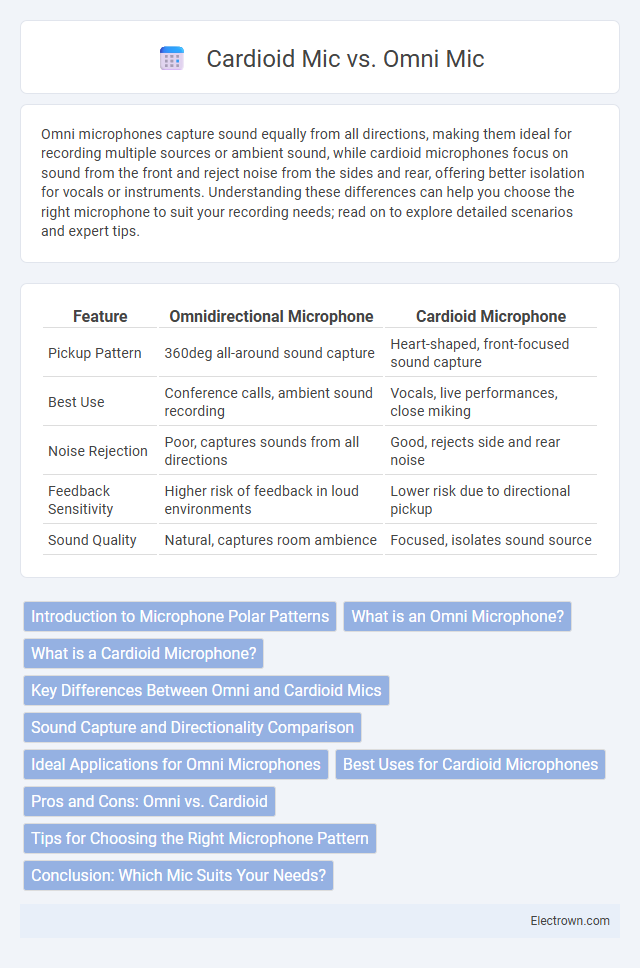Omni microphones capture sound equally from all directions, making them ideal for recording multiple sources or ambient sound, while cardioid microphones focus on sound from the front and reject noise from the sides and rear, offering better isolation for vocals or instruments. Understanding these differences can help you choose the right microphone to suit your recording needs; read on to explore detailed scenarios and expert tips.
Table of Comparison
| Feature | Omnidirectional Microphone | Cardioid Microphone |
|---|---|---|
| Pickup Pattern | 360deg all-around sound capture | Heart-shaped, front-focused sound capture |
| Best Use | Conference calls, ambient sound recording | Vocals, live performances, close miking |
| Noise Rejection | Poor, captures sounds from all directions | Good, rejects side and rear noise |
| Feedback Sensitivity | Higher risk of feedback in loud environments | Lower risk due to directional pickup |
| Sound Quality | Natural, captures room ambience | Focused, isolates sound source |
Introduction to Microphone Polar Patterns
Microphone polar patterns define how a mic captures sound from different directions, influencing audio clarity and fit for specific environments. Omni mics pick up sound equally from all directions, ideal for capturing ambient or group audio, while cardioid mics focus on sounds from the front, minimizing background noise for clearer vocals or instruments. Understanding your environment and purpose helps you choose the right pattern to optimize sound quality and performance.
What is an Omni Microphone?
An omni microphone captures sound equally from all directions, making it ideal for recording ambient sounds or group conversations where multiple sources are present. Unlike cardioid microphones, which focus on sound from one primary direction and minimize background noise, omni mics provide a natural, open sound without directional bias. Choosing an omni microphone can enhance your recordings when you need to capture the full acoustic environment.
What is a Cardioid Microphone?
A cardioid microphone is designed to capture sound primarily from the front while rejecting noise from the sides and rear, creating a heart-shaped pickup pattern. This directional sensitivity makes cardioid mics ideal for live performances and recording environments where isolating the main sound source is essential. Cardioid microphones reduce background noise and feedback, enhancing vocal clarity and instrument separation.
Key Differences Between Omni and Cardioid Mics
Omni microphones capture sound equally from all directions, making them ideal for recording ambient noise or group conversations, while cardioid microphones focus on sound from the front and reduce pickup from the sides and rear, enhancing vocal clarity and minimizing background noise. Cardioid mics are favored for live performances and studio vocals due to their directional pattern that isolates the sound source, whereas omni mics excel in capturing natural room acoustics. Your choice depends on the recording environment and the desired sound isolation or ambient capture.
Sound Capture and Directionality Comparison
Omni microphones capture sound equally from all directions, making them ideal for recording ambient noise or multiple sources simultaneously. Cardioid microphones focus on sound from the front while minimizing noise from the sides and rear, providing clearer audio in noisy environments. Choosing the right mic type enhances your recording quality based on the desired sound capture and directionality.
Ideal Applications for Omni Microphones
Omni microphones capture sound equally from all directions, making them ideal for applications like conference calls, choir recordings, and ambient sound capture where a natural, immersive audio environment is desired. They excel in situations requiring consistent sensitivity across a wide area, such as capturing group discussions or environmental sounds in film production. Omni mics provide a balanced, clear representation of the acoustic surroundings without emphasizing a single sound source.
Best Uses for Cardioid Microphones
Cardioid microphones excel at capturing sound directly in front while minimizing ambient noise and feedback, making them ideal for live performances, podcasting, and vocal recording. Their directional pickup pattern ensures clear audio in environments with background noise, enhancing your voice's clarity and presence. These mics are particularly effective in studio settings and stages where isolating sound sources is crucial.
Pros and Cons: Omni vs. Cardioid
Omnidirectional microphones capture sound equally from all directions, providing natural, immersive audio ideal for group settings but are more susceptible to background noise and feedback. Cardioid microphones focus on sound from the front while rejecting noise from the sides and rear, offering better isolation and clarity in noisy environments but can cause off-axis coloration and require precise positioning. Choosing between omni and cardioid depends on the recording scenario, balancing ambient sound capture with noise rejection needs.
Tips for Choosing the Right Microphone Pattern
Omni microphone patterns capture sound equally from all directions, making them ideal for recording ambient sounds or group vocals in controlled environments. Cardioid mics focus on sound from the front while minimizing background noise, perfect for isolating your voice in noisy settings or live performances. Consider the recording environment and desired sound clarity when choosing between omni and cardioid mic patterns to ensure the best audio quality.
Conclusion: Which Mic Suits Your Needs?
Choosing between omni and cardioid microphones depends on your recording environment and sound isolation needs. Omni mics capture sound equally from all directions, ideal for capturing ambient or group recordings, while cardioid mics focus on sound from the front, reducing background noise and feedback, making them suitable for solo vocals or noisy settings. For podcasting, live performances, or studio recordings requiring clarity and noise rejection, cardioid microphones are often preferred, whereas omni mics excel in capturing natural acoustics and multiple sound sources.
omni vs cardioid mic Infographic

 electrown.com
electrown.com